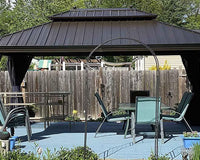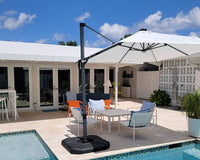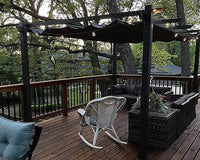Creating your dream outdoor space? A pergola adorned with climbing plants might be exactly what you need. These living canopies transform simple structures into breathtaking garden features, offering natural shade, enhanced privacy, and stunning visual appeal. Whether you're drawn to the cascading purple blooms of wisteria or the sweet fragrance of honeysuckle, choosing the right climbing plant can make all the difference. In this guide, we'll talk about five spectacular climbing plants that are perfect for pergolas, considering factors like growth rate, maintenance requirements, and climate adaptability to help you make the best choice for your outdoor space.
Essential Considerations Before Choosing Pergola Plants
Consider five crucial factors that will ensure your climbing plants thrive on your pergola.
First, check your pergola's strength. Different material means different strength.Mature vines like wisteria can weigh hundreds of pounds, so your structure needs to be sturdy enough to handle the load.
Next, know your climate zone. This determines which plants will survive in your area and helps predict their growth patterns throughout the year.
Sun exposure is equally important. Track how much direct sunlight your pergola receives daily, as different plants have varying light requirements.
Consider your maintenance commitment. Some vines grow rapidly and need frequent pruning, while others are more low-maintenance. Be realistic about the time you can dedicate to care.
Finally, think about seasonal changes. Some plants lose leaves in winter, while others provide year-round coverage. Understanding these patterns helps you choose plants that match your expectations.
1. Wisteria
With its cascading purple blooms and enchanting fragrance, wisteria transforms any pergola into a magical garden feature. This vigorous climber can reach lengths of 30+ feet, creating a stunning overhead display of hanging flower clusters up to 3 feet long providing shade-giving properties. Available in purple, pink, blue, or white varieties, each offering a sweet, subtle scent that peaks during full bloom.
For successful growth, plant wisteria in well-draining soil with a pH of 6.0–7.0. While young plants need regular watering, established vines are quite drought-tolerant. The key to abundant blooms lies in proper pruning: twice a year, in late winter for shape and mid-summer for control.
Best suited for USDA zones 5-9, wisteria requires a sturdy pergola due to its substantial weight when mature. Plant in full sun for optimal flowering, and be patient; it may take 3-5 years to see first blooms. Choose grafted plants if you want faster results.
Perfect for gardeners seeking dramatic impact and dense shade, but keep this in mind: this beauty demands commitment to regular pruning to keep its vigorous growth in check.
2. Climbing Roses
Climbing roses bring a perfect blend of romance and functionality to any pergola. They offer repeat blooming throughout the season, with varieties ranging from delicate pastels to vibrant hues.
Most climbing roses grow 8–12 feet tall, making them ideal for standard pergola heights. Popular varieties like 'New Dawn' (soft pink), 'Lady of Shalott' (salmon), and 'Zephirine Drouhin' (deep rose) offer consistent blooming from late spring through fall. Growth is moderate, typically reaching full coverage within 2-3 seasons.
Plant climbing roses in spring or fall in rich, well-draining soil with full sun exposure. They need sturdy support systems—attach main canes horizontally to encourage flowering along the entire stem. Feed monthly during the growing season with rose-specific fertilizer and maintain good air circulation to prevent common issues like black spots or powdery mildew.
Best suited for USDA zones 5-10, climbing roses create the perfect centerpiece for traditional gardens and romantic outdoor spaces. While they don't provide dense shade like wisteria, they offer unmatched aesthetic appeal with their continuous display of blooms and glossy foliage.
3. Clematis
Known as the queen of climbing vines, clematis offers incredible variety for pergola coverage with stunning blooms in almost every color imaginable.
Key Features
- Spectacular flowers from pure white to deep purple
- Size ranges from 8-20 feet, depending on variety
- Blooming period from late spring to early fall
- Choose from large single blooms (6-8") or abundant smaller clusters
Growing Guide
1. Plant with "head in the sun, feet in the shade."
2. Set roots 3 inches below soil surface
3. Mulch well to keep roots cool and moist
4. Support with thin wires or string
5. Three pruning groups:
- Group 1: Prune after flowering
- Group 2: Light spring prune
- Group 3: Hard prune in late winter
Best For
- Mixed planting schemes (especially with roses)
- All pergola sizes
- Various garden styles, from cottage to modern
- Year-round interest with proper variety selection

4. Honeysuckle
Honeysuckle combines rapid growth with intoxicating fragrance, making it a great choice for pergola coverage. Whether you choose native varieties like Lonicera sempervirens or cultivated Japanese honeysuckle, these vines offer both beauty and wildlife benefits.
Most varieties bloom from late spring through summer, producing tubular flowers in shades of cream, yellow, pink, or red. Native varieties attract hummingbirds and butterflies while providing late-summer berries for birds. Expect growth of 10-20 feet, with vines filling in quickly during the growing season.
Plant in well-draining soil in full sun to partial shade. While established plants are drought-tolerant, regular watering promotes better flowering. Train young vines by gently weaving them through pergola supports, and trim back vigorous growth twice a year to prevent tangling. For invasive control, choose native species or sterile cultivars, and remove stray shoots promptly. Winter care is minimal—simply cut back dead or damaged vines in early spring.
Perfect for creating fragrant seating areas and wildlife-friendly gardens. Choose honeysuckle when you need quick coverage; it typically covers a pergola within two growing seasons. Ideal for gardeners seeking a low-maintenance, high-reward vine.
5. Grape Vines
Grapevines offer a unique combination of beauty and functionality, providing both dense shade and potentially delicious harvests.
Traditional wine varieties like 'Cabernet' and table grapes such as 'Concord' produce edible fruit, while ornamental varieties focus on foliage display. Large, lobed leaves create excellent summer shade, turning golden or crimson in fall. Most varieties grow 15-20 feet annually with proper support.
Plant in full sun with well-draining soil. Train main stems horizontally along pergola supports, pruning side shoots regularly. For fruiting varieties, winter pruning is crucial—remove up to 90% of the previous year's growth. Harvest typically occurs in late summer to early fall, depending on variety.
Perfect for Mediterranean-style gardens and edible landscapes. Choose grapevines when you want substantial summer shade with the bonus of fall color. It's ideal for outdoor dining areas.




